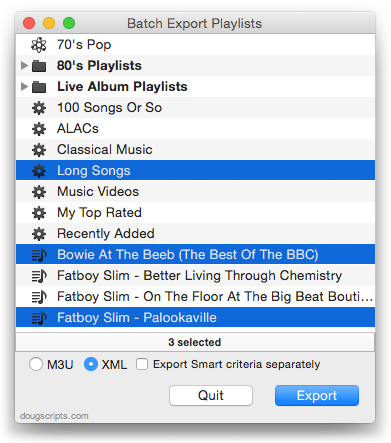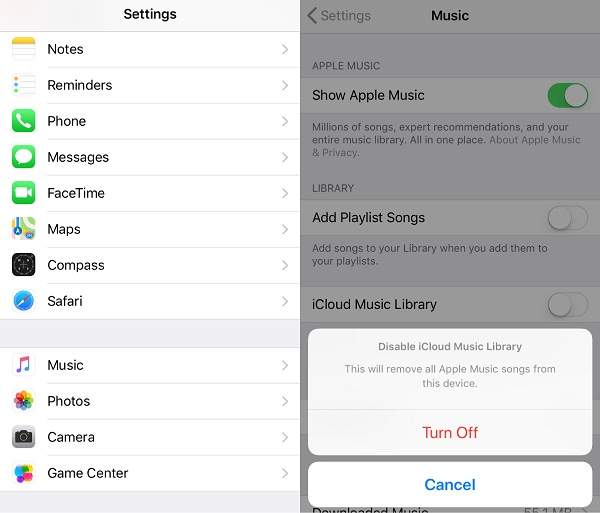- Batch Export Playlists Music App Mac Desktop
- Batch Export Playlists Music App Mac Free
- Batch Export Playlists Music App Macbook
iTunes Export
Introduction - Download - Using - FAQ - License - Change Log
Playlist Export, a native Mac OSX application based on iTunes Export is available in the Mac App Store. Check it out!
Introduction
iTunes Export exports playlists defined in your iTunes Music Library to standard .m3u, .wpl (Windows Media), .zpl (Zune), or .mpl (Centrafuse) playlists. iTunes Export also supports copying the original music files with the playlist to facilitate exporting to other devices. iTunes Export is open source and freely available for use.
iTunes Export comes in two versions:
Check out the playlists in your Music app. If the iTunes duplicate playlists problem still exists, try other solutions. Delete the affected playlists from Music on your device. We can also manually delete all the duplicate iTunes playlist and sync with iPhone again to remove duplicate playlist in both iTunes and iPhone.
- Graphical User Interface - An easy to use version.
- Command Line Version - Supports automated processes and scripting.
Both versions, and the source code are available for download from the Download section.
- Car Playlist: 1 click to transfer downloaded music and playlist to USB drive to enjoy in car. Burn DVD: Ability to burn downloaded songs and playlists to CDs with iMusic. Built-in Music Player: Stream any music and play the music you downloaded from the Internet on iMusic.
- BUT - all my old PLAYLISTS are gone. I was able to do this: - manually export an old playlist from the old computer - open the.txt file and change the file path to the new hard drive - import that playlist on the new computer - VOILA - GREAT, I was able to relink the selected playlist BUT: THERE ARE OVER 500 playlists.
International Support - iTunes Export is now available in multiple language. English and French are available today. If you are willing and able to translate other languages please let me know!
The 1.x branch of iTunes Export was written using the .Net Framework. This version only worked on Windows, and was deprecated in favor of the new 2.0 branch built using Adobe AIR and Java (Scala) for the GUI and Console versions receptively. If you need to use this older branch for some reason it is available here.
Have a questions, please review the FAQ. If it does not answer your question please email me at eric@ericdaugherty.com
If you like iTunes Export and would like to make a donation, you can do so here.
Download
GUI Application - Version 2.2.2
The Adobe AIR installer package has expired. To install, please set your system clock back to ~Oct 2017 and install. Once installed you can revert your clock to the current time.
Download iTunesExport now.
This application requires Adobe® AIR™ to be installed for Mac OS or Windows.
If you are having issues with the installer you can download the air file directly here.
Console Application - Version 2.2.3
Download
Application Source
 GitHub Source Repository
GitHub Source RepositoryUsing iTunes Export
iTunes Export UI

iTunes Export UI is a Graphical application that provides a wizard based interface to export your iTunes playlists to m3u files.
To use iTunes Export GUI, simply launch iTunesExport and follow the instructions.
iTunes Export Command Line
iTunes Export is a command line application that uses the Java Runtime Environment (JRE) to execute. To use it, extract the downloaded zip file to a directory, open a command window and execute the following command:
If iTunes Export is run without any parameters, it will attempt to locate your iTunes Music Library and will write a .m3u playlist file for each playlist defined in the iTunes Music Library. You can specify the -? or -h parameters for a list of allowed parameters.
The location of the iTunes Music Library can be overridden using a command line parameter. Example:
iTunes Export will write the playlists to the current directory unless an output directory is specified. Example:
iTunes Export allows you to export playlists using a variety of formats. By default, playlists are exported at M3U playlists, but you can use the following parameter to change to EXT, WPL, ZPL, or MPL:
iTunes Export will use the absolute location of your music files in the playlist. iTunes Export accepts a command line parameter that will override this default. Example:
iTunes Export will only apply the prefix to tracks stored in the directory configured in iTunes as the iTunes Music Folder location. Files stored in a different directory will not have the prefix applied.
If you only wish to override a portion of the music path you can specifi the musicPathOld parameter. iTunes Export will replace this path with the musicPath parameter instead of replacing the default music path.
By default, iTunes Export will exclude the 'built in' playlists, such as Music and Movies. If you want to include these, you can use the includeBuiltInPlaylists option.
If you wish to exclude some playlists from the export, you can specify them using the -excludePlaylist command line parameter. This takes a single or list of playlists that will not be exported.
If you wish to include only a subset of your playlists in the export, you can specify them using the -includePlaylist command line parameter. This takes a single or list of playlists that will be exported.
By default only MP3 files are included in the export. This can be overriden with the -fileTypes paremeter. The values are: ALL, MP3, MP3M4A. MP3M4A includes both MP3 and M4A files.

When exporting M3U playlists you can specify the -useM3U8Ext parameter to use the m3u8 extension instead of the default m3u.
In some cases, media players don't treat the contents of M3U files (standard or extended) as Unicode. This causes problems when those files contain international characters. For those media players, changing the playlist file extension to M3U8 prompts the player to treat the contents as Unicode. During testing, this seemed to be the case for playlist files that contained special characters and were being run on a non-English version of Windows. If your playlists contain any special characters () and you're running on an international version of Windows, you may wish to use the -useM3U8Ext parameter.
Batch Export Playlists Music App Mac Desktop

Batch Export Playlists Music App Mac Free
iTunes allows you to uncheck (deselect) songs. Be default iTunes Export ignores these songs. You can override this default with the -includeDisabled parameter.
Batch Export Playlists Music App Macbook
You can choose to have iTunes Export copy your music files to an output directory. Three seperate modes are supported. FLAT - Copies all the files into the output directory. ITUNES - Copies the files retaining the iTunes structure (Artist/Album). PLAYLIST - Copies the songs into a folder per playlist.